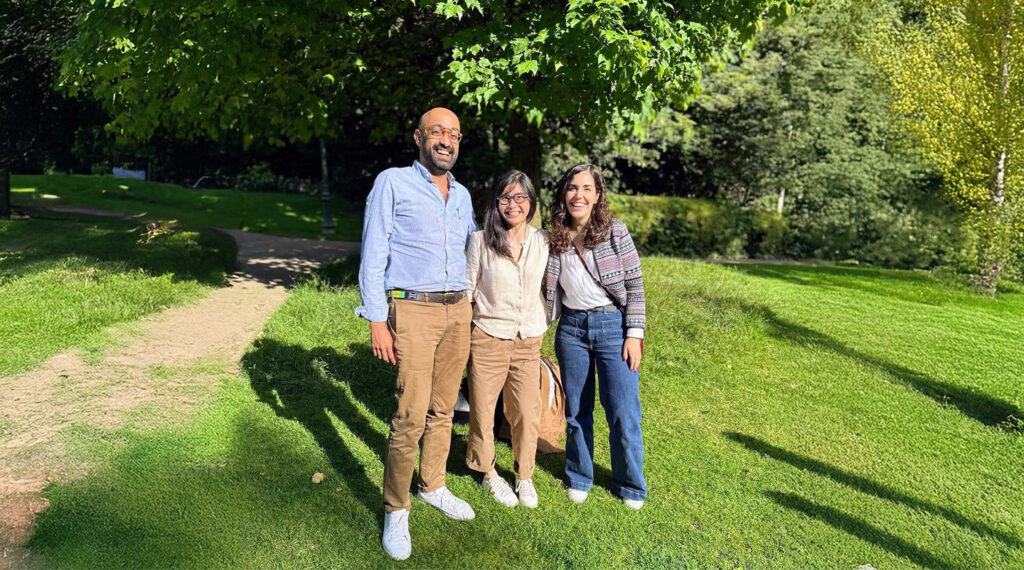Co-Leadership at EPIM: A philanthropic model for growth, collaborative innovation and organisational success

A little over a year ago, the European Philanthropic Initiative for Migration (EPIM), adopted a co-leadership structure, making it one of the first major philanthropic organisations in Europe to do so. Co-Director’s Sophie and Hrishabh interviewed each other reflecting on highs and lows, and what it takes to make the model work.
Sophie: A year into EPIM’s co-leadership model, what has been your experience so far?
Hrishabh: For the lack of a better word, I think it has been brilliant. A rewarding experience, in which I’ve learned a lot, grown a fair bit, and supported someone else to come into their own. This is what leadership should be about – a reinforcing mutual growth loop, unlike most of the other models out there.
Sophie: What have been the benefits for EPIM and for you personally?
Hrishabh: Purely from a capacity and capability, standpoint, I think dual leadership has provided a huge boost to EPIM, especially at the dawn of this period of organisational reinvention. And I think the fact that both of us have personal and professional experience of migration in Europe gives EPIM real credibility – a duality it has rarely had before at the helm. This results in better decisions, more innovation and a culture at EPIM that values collaboration above all – ultimately, that is a huge win.
Leadership can be a terribly lonely affair. Personally, the sense of comfort knowing that someone else out there is dealing with the same sets of issues you are, makes a huge difference in terms of support. And then there is the acquisition of new skills, emergence of new ideas and even the adoption of new tech and apps. As someone who is perpetually in search of novelty, co-leadership has been great for my brain.
Hrishabh: What is your approach to differences in opinion, conflict (if-ever) and feedback?
Sophie: Let’s start with what we have in common. Hrishabh and I are fundamentally aligned in our vision for EPIM and the deeper purpose behind it, even if we might at times differ on the path.
We’ve navigated disagreements and exchanged frankly on issues before we stepped into this role. We have learned to communicate openly, listen deeply, provide feedback, and apologise. We know when to agree to disagree and try to laugh things off before they become frustrations. Our feedback loops are constant, and we understand when and where to express differences. This reflects our ongoing work with our egos and on balancing personal and shared ambitions.
Sophie: What have been some of the challenges?
Hrishabh: I’ve honestly been far more surprised by (and grateful for) how well this has worked out. There have been no major challenges in that sense.
As senior programme managers, both Sophie and I initially tiptoed around each other and then had a full year to figure out working styles, areas of competence and how to prototype collaboration before taking on this role. That initiation period allowed us to build an implicit trust.
A more practical issue though is how much work we’re taking on and how ambitious we both are for EPIM and where we want it to go with us at the helm (and for the years beyond), making full use of the dual capacities this structure creates. I think this often translates into lofty goals and sacrificing down-time and a work-life balance, and that too is a challenge.
Hrishabh: How do you/we address the division of power and responsibility between two co-leaders, both in terms in practical delivery of work and public positioning?
Sophie: Things have been happening organically. Besides defined roles in communications and finance, everything else happens with fluidity, based on our capacity and energy. It is like reaching a state of flow. We’ve also freed ourselves from rigid structures and pre-assigned responsibilities, allowing for creativity and growth. We share power by co-designing, feeding each other’s work, and coaching one another. When it comes to public positioning, Hrishabh and I speak to different audiences. While our ideas may be the same, how we each convey them is inimitable and resonates differently. We leverage our strengths and complementarity to share responsibility.
Sophie: What makes it work on a daily basis?
Hrishabh: An implicit trust that the other person knows what they are doing. A respect for the other’s judgement and skillset, and a belief in a shared higher purpose for this work, that we are intentionally choosing to do together.
And in a lighter vein – humour and Sophie’s unabashed ability to hold me accountable and bring me back to earth with a few circumspect words.
Hrishabh: How much difference does our shared lived experience of the issues at hand make to the co-leadership model? Would this have still been possible if the other did not, have it?
Sophie: It spares me explanation and emotional labour. Our shared experiences as (perceived) migrants doing the work we do creates an unspoken bond. While this may be particularly salient at EPIM, it does not entirely define us. We each bring multifaceted experiences to our work, some shared and some that are not. Our lived experience of migration and racialisation doesn’t automatically make us good leaders and doesn’t always define the vision we have for EPIM.
What is key is the self-awareness our positionality within the migration ecosystem, and how we use it as a base for EPIM’s vision. This self-awareness is what I would have sought in any co-leader.
Hrishabh: How do you handle ambition, especially when personal ambition needs to become shared ambition?
Sophie: To me, it’s clear that our ambitions are focused on the cause, not just career development. That doesn’t mean we’re not ambitious – we both are – especially when it comes to EPIM. We are deeply purpose-driven which brings its own challenges, like the fear of not doing enough or falling behind.
Things have of course not always been this way. When we started working together in 2022, we cautiously navigated our roles in a structure where the division of responsibilities was more pre-defined. It was only when both of us felt secure that we began to embrace a more fluid approach. Titles have never been a priority for me. Because I have the necessary freedom, respect and alignment with my values and heart, I can put my personal ambitions at the service of our shared ambitions.
Sophie: What recommendation would you offer to organisations considering a shift to a co-leadership model?
Hrishabh: There are two questions here, the first, do you as an institution considering this model, have the organisational culture and environment in place to foster a shared leadership structure – is there already some sort of shared, distributed and decentralised leadership structure and collaborative culture in place, where this will not be a novelty or seen as too much of a gimmick and be actually implementable?
And second, are you going to be able to find the right combination of individuals to do this together. It’s not impossible, but if you bring in folks from more traditional hierarchal structures and schools of leadership, it might be a challenge.
So, ideally, what you want is a distributed leadership in environment already in place, and second, leaders who are familiar with it, or have worked in co-leadership before (or are willing to view leadership differently).
Authors


